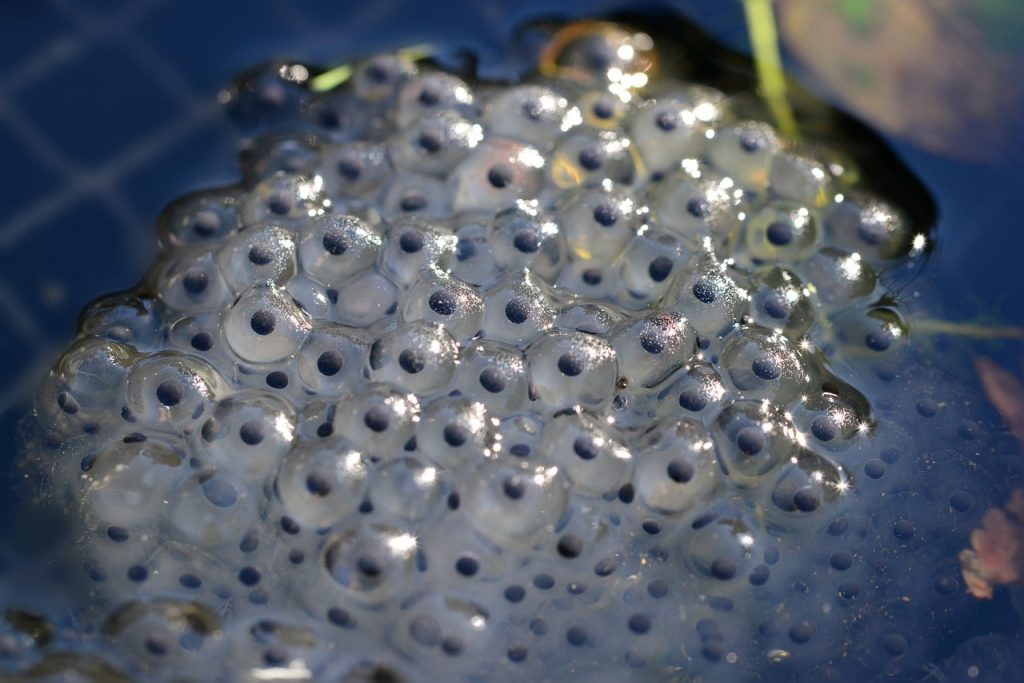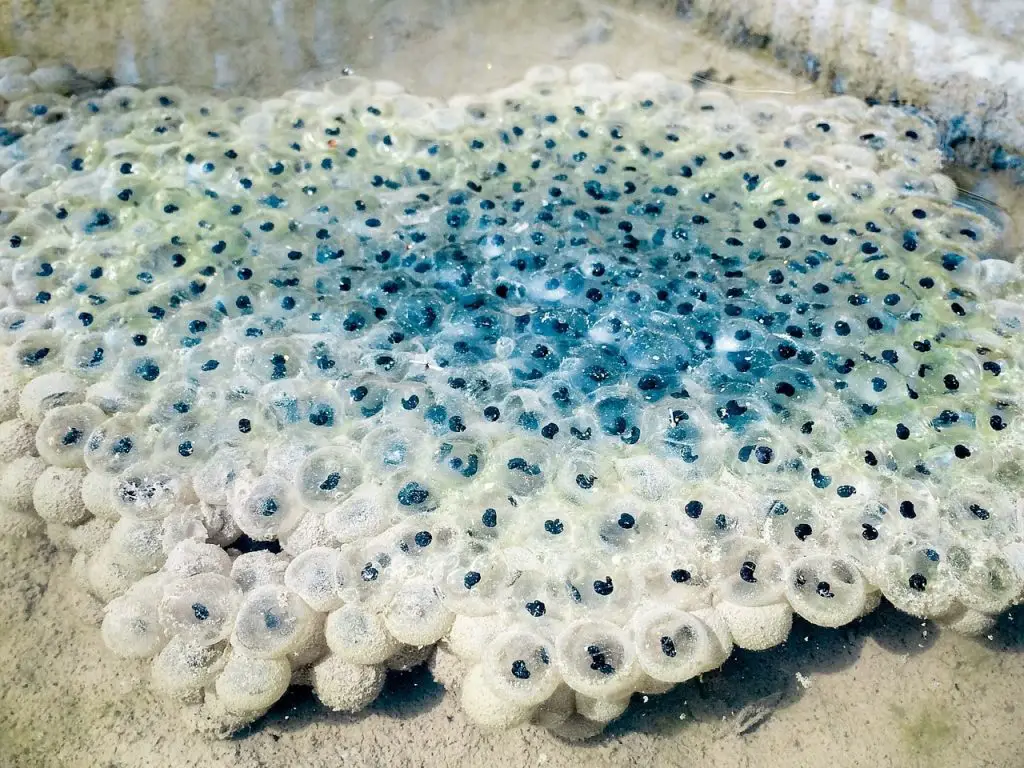
There are lots of types of amphibians and they all have certain things in common. One of these things is that (with a few exceptions) amphibians lay eggs.
In this sense, amphibians are more like fish or birds than they are like mammals. Mammals (including humans) give birth to live young. Birds, fish and almost all amphibians are different – they lay eggs, which then hatch when their babies are ready.
Amphibian eggs are different to the hard-shelled eggs of birds and reptiles though. Amphibians lay soft eggs without shells.
Do amphibians lay eggs in water or on land?
So, why do amphibians lay their eggs in water? The answer is two-fold.
First, amphibians lay their eggs in water because the fertilized eggs can survive there. To make the chance of surviving bigger, they try to lay their eggs in water without fish.
Second, if they didn’t lay their eggs in water, the eggs would suffer from dehydration from the sun.
Laying eggs is water is one of the things that separates amphibians from reptiles.
Related article: What are amphibians?

Why do amphibians lay eggs in water?
I’ll try to explain it a bit further… Amphibians eggs do not have a hard shell. So, by laying their eggs in water, they are using the water to protect the eggs from dehydrating.
Imagine an amphibian laying its eggs somewhere without water, out in the sunshine. The eggs would dry up in no time and kill the possible offspring. That is why amphibians lay their eggs in water.
Want to know more about what amphibians do to protect their young? Read the article I wrote about the subject right here.
Another thing is the fact that tadpoles don’t have legs yet and therefore wouldn’t survive on land. They would be easy prey for other animals. When amphibians lay their eggs in water, the tadpoles and larvae can feed themselves micro plants and algae to develop into full-grown frogs, toads, newts, and salamanders.
How do amphibians breed
How do frogs breed
When we look at the breeding ritual of a frog, we see that it is very simple. First, the male and female frog get into a mating posture. This mating posture is called amplexus. This is the posture where the male frog climbs on top of the female’s back and with his forelegs, grabs the female around her middle.
Do you want to know how much eggs a female frog lays? Read the article I wrote about it here.
They can stay in this position for hours or even days depending on the release of eggs of the female (do you want to know how much eggs a female releases? I wrote a whole article about it and you can find it here). When the female lays her eggs, the male releases his sperm at the same time and sprays it over the eggs to fertilize them.
How do toads breed
With toads, the mating ritual is largely the same. The male clutches the female from behind and hold her tight. He then goes on fertilizing the long and triple-stranded strings of the eggs of the female as she lays them. When all is well the tadpoles hatch after a day or 10 and then gradually change completely into a toad over the course of two to three months.
How do salamanders breed
Breeding in salamanders is quite a bit different from the frogs and toads. Where frogs and toads mostly fertilize externally, in salamanders it happens internally for around 90% of the species of salamanders.
This means that the male will deposit sperm (also called spermatophore comprised of 80 – 100 sperms) on the ground, a rock or stick and then tries to lead the female into this area. Then the female proceeds to pick up the spermatophore with her cloacal lips and then go to a pond or ditch. When she is there, she will lay the eggs and make sure the eggs stay moist.
In some species, this also works the other way around. Female salamanders will lay eggs in a nest under a rock and then the male salamander will fertilize the eggs and watch over the nest. This he then does until the younglings hatch.
How do newts breed
The way newts breed is almost exactly the same as that salamanders do it. But fun to know is the fact that some species, such as the California newts and the rough-skinned newt do a mating dance!

How do amphibians fertilize their eggs?
Amphibians fertilize their eggs in two ways. I have explained them a bit already in the above section but will go into a little more detail now.
External fertilization
Let me give you an example of frogs. Male frogs will go to nearby ponds (or sometimes go back to the ponds they were born in), still water and other places (like trees, the ground, it doesn’t have to be water) to start the breeding.
During the night the male frogs will call for female mates in the hope that a female frog finds her croaking attractive and comes to visit him. When that happens, the male jumps on the back of the female and grips himself around her middle.
Then something called the cloaca (this is the opening where sperm comes out and in females, it is the opening where eggs come out) is used to release the eggs of the female. When the female releases the eggs, the male frog then proceeds to spray sperm over them and so fertilizing the egg.
It can also happen that multiple male frogs jump on a female and they sometimes even form giant piles of frogs! This can become so rough that the female dies… But normally, when the male and female frog are done mating, the female goes her way and the male frog goes his.
Internal fertilization
If we talk about internal fertilization, we can look at salamanders who do exactly that. With salamanders, it is not only the male that looks for a female, but it is also the other way around. This happens in the spring as the warm rain falls. But how is the fertilization done exactly? The male salamander will deposit something that is called a spermatophore.
This is a bundle of sperms that contains about 80 to 100 sperms. He lays this on the ground, on rocks, sticks and leads the female to his sperm. When this is successfully done, the female salamanders picks up the spermatophore with her cloacal lips, fertilizes the eggs with the sperm, and then off she goes to a pond or a nearby ditch and lays her eggs.
How do amphibians find a mate?
This is largely dependent on what kind of amphibians and species we talk about. Below I’ll describe the general information about the mating of different amphibian species.
What is Amplexus?
Amplexus term refers to a mating position of frogs and toads,
As part of the mating procedure, male frogs grasps the female with their front legs (forelimbs). and fertilizes the egg’s laid by female frogs by spraying the liquid that contains male spermatozoa.
Frogs
Frogs like to sing to attract females. They sing by taking in a deep breathe, closing their mouth and nostrils and then, when they blow air over the vocal cords, the vocal sac inflates.
Want to learn more about how frogs croak and why? I wrote this article where you can find all the information.
Toads
With toads, this is a bit different. When a male finds a female, he will just hitch a ride on her back when the female goes to the pond. When she reaches the pond it can happen that a whole lot of male toads have followed her. As I said earlier, it can even be so that multiple toads try to mount the female. It is a funny ritual to see!
Salamanders
The mating season of the salamanders starts after the first rains of spring. They do this so that they can stay clear from extreme environmental conditions. To let the other know that they are interested in mating, salamanders do all kinds of things. There is the California newt who will pick the potential mate by smelling them. European crested newts (the males) can let females know they want to mate by changing their skin color and even their patterns.
